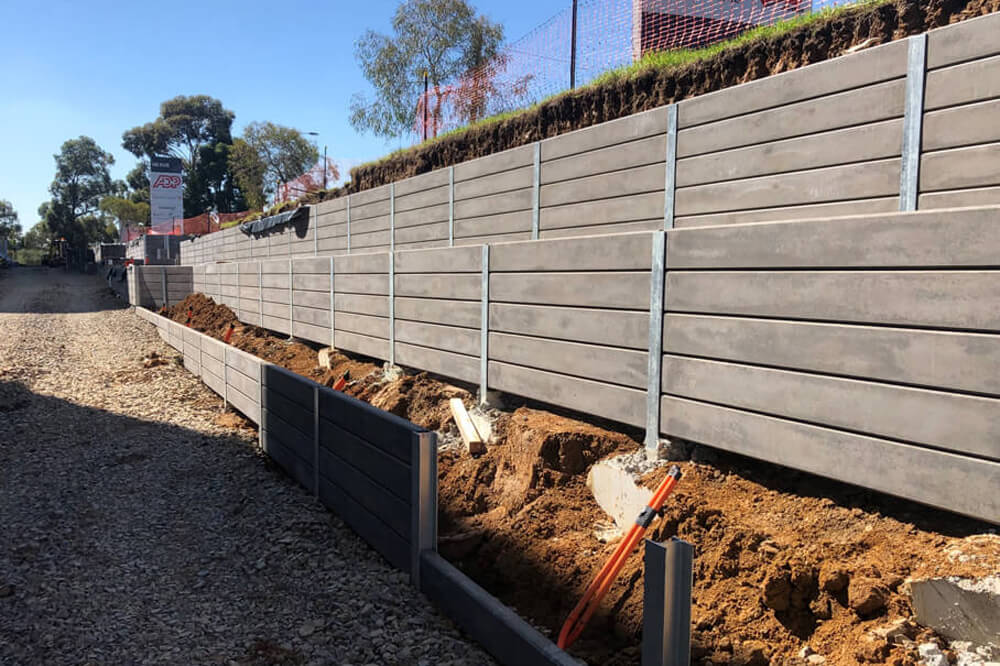 Concrete retaining walls are an essential and versatile element in many landscape designs, providing both structural support and aesthetic appeal. These sturdy structures are meticulously engineered to hold back soil, prevent erosion, and create level spaces in sloped areas. In this comprehensive article, we will explore the strength, function, and importance of concrete retaining walls in landscaping projects, shedding light on their numerous benefits and the value they bring to outdoor spaces. What Are Concrete Retaining Walls?
Concrete retaining walls are vertical structures constructed using concrete blocks, poured concrete, or precast concrete panels. They are specifically designed to retain soil and create terraced or leveled areas on properties with sloped terrain. These walls play a vital role in preventing soil erosion, offering stability to landscapes, and creating visually appealing outdoor environments. Structural Integrity and Strength: One of the most notable features of concrete retaining walls is their exceptional strength and durability. Concrete, as a material, possesses outstanding compressive strength and resilience to weathering, making it an ideal choice for constructing retaining walls. Additionally, reinforcing techniques such as the inclusion of steel bars or mesh embedded within the concrete significantly enhance the walls' structural integrity and load-bearing capacity. This robust construction ensures that the walls can withstand the lateral pressure exerted by soil, retaining their form and function over the long term. Erosion Control and Soil Stability: The primary function of concrete retaining walls is to control erosion and maintain soil stability. In areas with sloped terrain, soil erosion can pose significant challenges, leading to the loss of valuable topsoil and causing structural problems. Concrete retaining walls act as reliable barriers, holding back soil and preventing its downward movement. This function is particularly crucial in regions prone to heavy rainfall or where the landscape features steep slopes. By mitigating erosion and soil displacement, these walls contribute to maintaining the integrity and longevity of the landscape. Creating Usable Spaces: One of the remarkable advantages of concrete retaining walls is their ability to transform previously unusable or sloped areas into functional spaces. By creating terraced or leveled sections, they provide stable and level platforms that can be utilized for various purposes. Homeowners can utilize these spaces for gardening, seating areas, outdoor entertainment, or recreational activities. The design flexibility offered by concrete retaining walls allows property owners to maximize the use of their land and create visually appealing landscapes that integrate seamlessly with the overall architectural style. Aesthetics and Design Options: While concrete retaining walls serve practical functions, they also offer aesthetic benefits. With various finishes, textures, and color options available, these walls can be customized to match the overall aesthetic of the landscape. Homeowners can choose finishes that blend harmoniously with the surrounding environment or opt for eye-catching designs that add a striking visual element to the outdoor space. Furthermore, concrete retaining walls can be enhanced with decorative features such as stone veneers or built-in planters, adding sophistication and charm to the landscape design. Environmental Benefits: Concrete retaining walls contribute to environmental conservation by reducing soil erosion and preventing runoff, which can carry pollutants into water bodies. By stabilizing the soil and creating level platforms, these walls promote water drainage and retention within the landscape. They also play a role in creating microclimates, which offer different planting opportunities and support biodiversity. In this way, concrete retaining walls positively impact the local ecosystem and contribute to sustainable landscaping practices. Conclusion: Concrete retaining walls are an indispensable component of modern landscaping projects. Their remarkable strength, durability, and erosion control capabilities make them invaluable for properties with sloped terrain. By preventing soil erosion, creating usable spaces, and offering design versatility, concrete retaining walls serve both practical and aesthetic purposes. They transform challenging landscapes into visually appealing and functional outdoor spaces while contributing to environmental conservation. As a result, these walls continue to be a popular choice for homeowners and landscape designers seeking to create lasting, visually stunning, and sustainable outdoor environments. Contact or call us for more information!
0 Comments
Leave a Reply. |
Archives
October 2023
Categories |
 RSS Feed
RSS Feed